

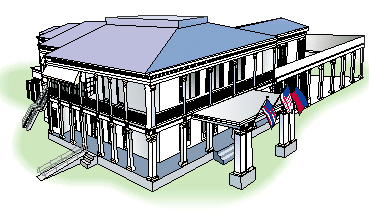
The building celebrates its 150th anniversary this month and there are a number of events scheduled, including an open house tomorrow.
It was built in 1846 by sea captain John Dominis, who originally hailed from Schenectady, N.Y., and who promptly sailed into oblivion in the China Seas. He left behind the widow Mary Dominis and son John Owen Dominis. She rented out the spare bedroom to American Commissioner Anthony TenEyck, another New Yawker, who took one look at the white manor with the grand columns out front and announced that it reminded him of Mount Vernon, George Washington's mansion.
He probably said, hey, this must be some sorta Washington-kine place, yeah?
In any event, since then, the Dominis house has been called Washington Place.
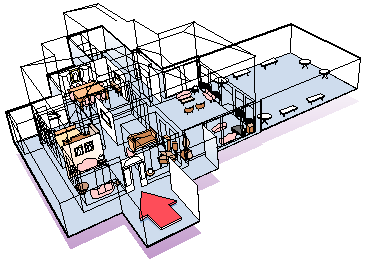
There was some unpleasantness involving politics and upstart businessmen in the 1890s, which required the queen - now the second widow Dominis to inhabit the home - to move into house arrest at Iolani Palace when she, or some supporters, used Washington Place to stash guns and ammunition for a counter-rebellion.
Once the United States annexed the islands during the Spanish-American War, home-rule politics became a moot point. The queen settled where she was most at home. Lydia Dominis described Washington Place "as comfortable in its appointments as it is inviting in its aspect."
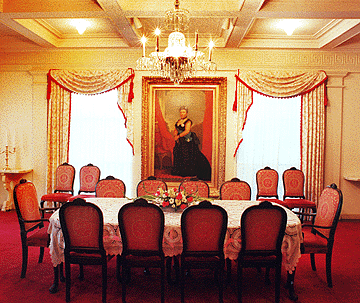
Dining room: The painting of Queen Liliuokalani is a reproduction. The original hangs at Iolani Palace.
Since then, the widow Dominis' home has been host to one gubernatorial family after another, each of which tinkered with the structure. Lanais have been walled in, porches extended, the upper floor redesigned, security features added - not to mention a bewildering number of decor accents that waxed and waned with fashion trends.
Today, it's the home of Gov. Benjamin Cayetano and his kids, Brandon and Samantha. While running for office in 1994, Cayetano declared that he would "return Washington Place to its rightful owners, the Hawaiian people ... her royal home was confiscated and it came to be the residence of the first territorial, and now state, governor ... for many years now, I have been thinking that we must all redress an historic wrong to the Hawaiian people and return to them the building and grounds. It is only right."
Since that campaign pledge, however, state attorneys have determined that Washington Place may be the only Hawaiian property the government acquired fair and square, and they've got the mortgage-payment booklets to prove it.
The Cayetanos moved in quietly after the election, and inhabit upper Washington Place and the kitchen area. These areas are currently off-limits to the public - unlike some previous administrations - and taxpayers can only speculate what it's like inside. Chrome and black Naugahyde? Budweiser bar clocks? Shag carpeting on the walls? A really bitchin' stereo? Lava lamps and bead curtains from Neil Abercrombie's old place?
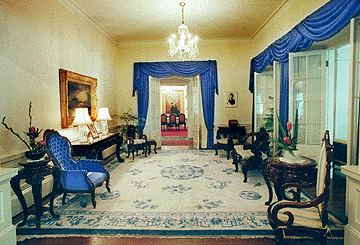
Blue & White room: This room is dominated by oriental funiture. On the right is an ornate double dragon chair. The chair was brought over from China in 1840 by the sea captain John Dominis for his wife Mary.
These are the areas open to the public tomorrow.
How do you even visit Washington Place? There's no doorbell, and the gates are locked. You wind up milling around on the sidewalk until a security guard notices you and checks you against his manifest.
Once through the gate, there's a grand porte cochere with three flags flying - U.S., State of Hawaii and ... what's that? It turns out to be the Governor's Flag, flown whenever he's in residence.
Our guide was Mary Peters, one of 12 unpaid Washington Place docents, a program created by Lynn Waihee, wife of the last governor.
It's difficult to get a sense of the widow Dominis' original Romance-era manor. It was substantially smaller at the time, with large open-air lanais that have since been walled in. This disrupted the way light and air entered the home.
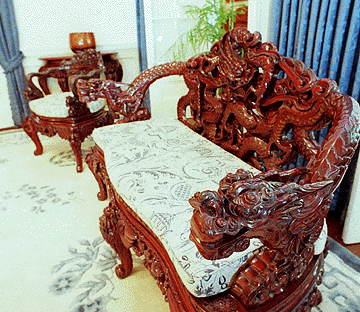
Blue & White room: Ornate carved dragon armrests on a chair.
The stairs are blocked by a trio of flags. Peters said that the governor almost never uses those stairs, otherwise he'd have to vault over the flags.
To the right are Liliuokalani's famous Fisher piano - given to her in 1891 by the same uppity businessmen who later rebelled - G-clef koa settee and the somber kahilis that followed her body to up Nuuanu. The silk wrappings on the kahilis are stained in a kind of sad stigmata.
"A while ago, (pianist) George Winston was here for a slack-key event, and he sat down and played 'Aloha Oe' on the queen's piano," said Peters.
The hallway has a Bishop Museum-looking display of the queen's personal items, including a wristlet made of her hanai father's hair. The exhibit case hides a large flat mirror that's very 1960s.
A lanai was added in the 1930s (Gov. Judd) and it was closed off and an additional lanai added in the 1950s (Gov. Long).
Most of the rooms sport Czech-crystal chandeliers apparently installed in the early 1970s.
The "Blue and White" room, to the right down the hallway, contains elaborately carved dragon furniture. To the left, around the stairway, is the queen's bedroom. The bed, which is 7 by 7 feet, actually belonged to Princess Ruth. Look under the large kapa and Hawaiian quilt and there are two mattresses, side by side. "Still stuffed with horse hair!" said Peters.
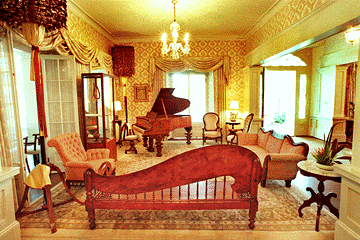
Music room: The piano was custom made of solid koa for Queen Liliuokalani. A solid koa tree was shipped to New York in 1891 and made into the piano which was a birthday gift to the queen. Kahili in the room were carried in the queen's funeral.
Behind the queen's bedroom, in what had been the rear lanai, an elevator (Gov. Stainbeck) connects the upper Washington Place to lower. Mrs. Burns, who was wheelchair-bound, was able to make good use of the elevator. By the elevator, and also behind the stairs, were two mystery doors that were locked.
What's behind there? "Oh, I don't know!" said Peters, cheerfully.
Beyond the built-over rear lanai - which now resembles a hallway - is a state dining room dominated by a reproduction of the queen's portrait and a mix of lighting out of "The Wild Wild West" and "The Jetsons." The official state plates are on display, as is the official state silver service, presented to Kamehameha IV by Napoleon III. (And you didn't realize that the IIIs even knew the IVs, did you?)
"They go through the dishwasher like all the other silverware," said Peters.
And that's about it for public space.
Beyond the dining room is the kitchen, which is locked up as well. What's it like in there?
"I think I can safely say that it has a stove and a refrigerator, things like that," said Peters. "There's no access to the kitchen; this isn't the good old days anymore. The kitchen can only make meals for 24; more than that and the affair has to be catered."
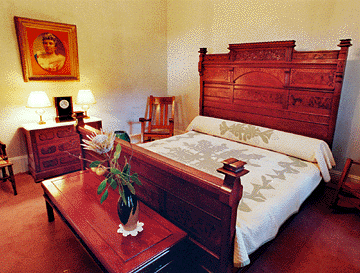
Princess Ruth's room: The bed is 7 by 7 feet, made up of two mattresses stuffed with horse hair.
The kitchen area also contains a "breakfast nook," and a stairwell installed by the Waihees during a massive renovation in the 1980s to the Historic Landmark structure. "Before that, the governor and the family had to go up and down by the fire escape," said Peters.
What if a light bulb goes out? Does the G replace his own light bulbs?
"If a light bulb goes out, then a staffer responds and notifies the Department of Accounting and General Services," said Peters.
And now you can supply your own punchline: How many DAGS workers does it take to screw in a light bulb?
What: Open house at Washington Place
When: 10 a.m. to 3 p.m. Saturday
Admission: Free
Hula and music to honor Queen Liliuokalani, featuring Leinaala Heine, Rick and Sol Hoopii, Kawaiahao Church Choir, Kamehameha Concert Glee Club and others; 10 a.m. to 2:30 p.m., Iolani Palace grounds.
Kamaaina Day tours of Iolani Palace; 9 a.m. to 2:15 p.m., first-come, first-served.
Judiciary History Center; 10 a.m. to 3 p.m., Aliiolani Hale, the Hawaii Supreme Court Building.
Commemorative display of Washington Place artifacts assembled by Bishop Museum; through Sunday, Liberty House downtown store.